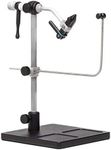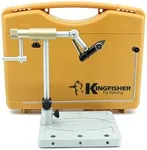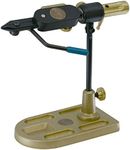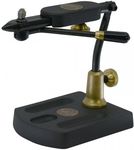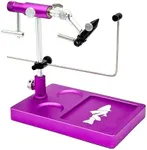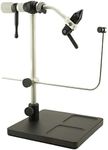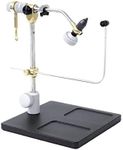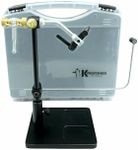Buying Guide for the Best Fly Tying Vises
Choosing the right fly-tying vise is crucial for any fly fisherman who ties their own flies. A good vise will hold your hook securely, allowing you to tie intricate patterns with ease and precision. When selecting a vise, consider the type of flies you will be tying, the size of the hooks, and your personal preferences for features and functionality. Here are some key specifications to consider when choosing a fly-tying vise.Jaw CapacityJaw capacity refers to the range of hook sizes that the vise can securely hold. This is important because different types of flies require different hook sizes. If you plan to tie a variety of flies, look for a vise with a wide jaw capacity that can accommodate both small and large hooks. For those who focus on specific types of flies, a vise with a more specialized jaw capacity might be sufficient. Consider the range of hook sizes you will be using most frequently to determine the right jaw capacity for you.
Rotary FunctionA rotary function allows the vise to rotate the hook 360 degrees, making it easier to access all sides of the fly while tying. This feature is particularly useful for tying complex patterns and ensuring even distribution of materials. There are two main types of rotary vises: true rotary and partial rotary. True rotary vises allow for full 360-degree rotation while maintaining the hook's axis, which is ideal for advanced tiers. Partial rotary vises offer some rotation but not as smoothly or precisely. If you are a beginner or tie simpler patterns, a partial rotary vise may be sufficient. For more advanced tiers, a true rotary vise can significantly enhance your tying experience.
Material and Build QualityThe material and build quality of a vise determine its durability and longevity. High-quality vises are typically made from materials like stainless steel, brass, or aluminum, which resist rust and wear over time. A well-built vise will hold hooks securely without slipping and will withstand the rigors of frequent use. When choosing a vise, consider how often you will be using it and in what conditions. If you tie flies frequently or in a variety of environments, investing in a high-quality, durable vise will be beneficial in the long run.
Base or ClampFly-tying vises come with either a base or a clamp for securing the vise to your work surface. A base is a flat, heavy platform that provides stability and can be used on any flat surface. A clamp attaches the vise to the edge of a table or bench, offering a more secure hold but requiring a suitable surface to clamp onto. If you need portability and flexibility in where you tie your flies, a vise with a base might be more convenient. If you have a dedicated tying station, a clamp can provide a more stable and secure setup.
AdjustabilityAdjustability refers to the ability to change the angle and position of the vise to suit your tying style and comfort. This can include features like adjustable jaws, height, and tilt. Greater adjustability allows you to customize the vise to your specific needs, making the tying process more comfortable and efficient. If you spend long hours tying flies or have specific ergonomic preferences, look for a vise with multiple points of adjustability. For occasional tiers, basic adjustability may be sufficient.

